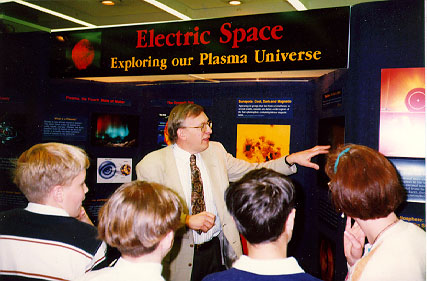Electric Space is a term coined in association with the Plasma Universe in the 1990s, to emphasize the importance of electric fields in the plasma throughout the Universe. [1] (Main article: Electric currents in space plasmas)
The “Electric Space” metaphor was coined by Dr. Carolyn T. Brown, Assistant Associate Librarian for Area Studies at the Library of Congress as the theme of the Space Science Institute traveling exhibition on the plasma universe supported by the National Oceanic and Atmospheric Administration and the National Science Foundation.[2][2b]
Contents
Electric Space exhibitions
“Electric Space” was further popularized in a series of commended [3] public exhibitions across the USA between April 1994 – 2001,[4][5] with the titles:
- “Electric Space: Exploring Our Plasma Universe”, and
- “Electric Space: Bolts, Jolts, and Volts from the Sun”
Conceived around 1992,[6] The exhibition was developed by the Space Science Institute [7] in Colorado, together with the Franklin Institute Science Museum in Philadelphia, Pennsylvania, the Association of Science and Technology Centers (ASTC) with funding from the Informal Science Education Program of the National Science Foundation‘s Education and Human Resources Directorate, and NASA’s Space Physics Division. NASA’s Space Science Data Operations Office (SSDOO) contributed by providing volunteers to act as scientist/guides, .[8].
The exhibition opened at the Maryland Science Center (Apr 1994), appeared at universities and museums, the American Museum of Science & Energy (Oct-Dec 1994), National Science Foundation (Oct 1996), International Space Center (Feb-Apr 1997), NOAA Science Learning Center (Aug-Sep 1996), Virginia Air and Space Center (Sep 1996 – Jan 1997), Epcott Center in Florida (Feb-Apr 1998), the Space Center Houston (Aug-Dec 1998), finally appearing at the Boonshoft Museum of Discovery (Jun-Aug 2001).
Displays
Source.[3]
Interactive displays
Video displays
|
Text panels
|
Footnotes
- ↑ Peratt, A. L., “Electric space: evolution of the plasma universe“, Astrophysics & Space Science, 244, 89-103 (1996) FULL TEXT PEER REVIEWED
- ↑ Anthony L. Peratt, “Advances in Numerical Modeling of Astrophysical and Space Plasmas“, Astrophysics and Space Science 242: 93-163, 1997. FULL TEXT PEER REVIEWED
- 2b ↑ Electric Space: Exploring our Plasma Universe (Award Abstract #9453798 ) at National Science Foundation
- ↑ 3.0 3.1 “Electric Space: A Summative Evaluation“, Randi Korn & Associates, Inc., 1997 FULL TEXT
- ↑ Space Science Institute, Schedule page at archive.org
- ↑ Association of Science-Technology Centers Incorporated, see page on archive.org
- ↑ Association of Science – Technology Centers Incorporated, Resource Center
- ↑ “Electric Space Exhibit Project“, (archive.org) Space Science Institute Web site
- ↑ James R. Thieman, “Electric Space Exhibit Opens to Public“, NASA Space Science Data Center
See also
- “Electric Space” at the Space Weather Center, sponsored by the Space Science Institute, National Science Foundation and NASA’s Living With A Star Program
- “A Virtual Tour of Electric Space“, a virtual exhibit at the Space Science Institute.
- “Electric Space, Exploring Our Plasma Universe” Museum: National Science Foundation; National Oceangraphic and Atmospheric Administration
- Electric Space exhibition at the Fort Lauderdale Museum of Discovery and Science
- Electric Space exhibit at the National Oceanic and Atmospheric Administration more
- Electric Space: Exploring our Plasma Universe at the Space Science Institute 1994 – 1998
